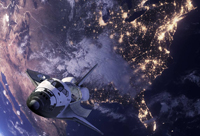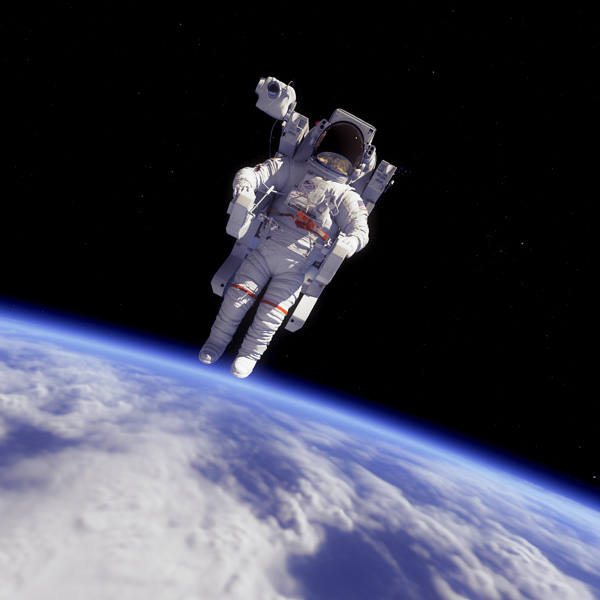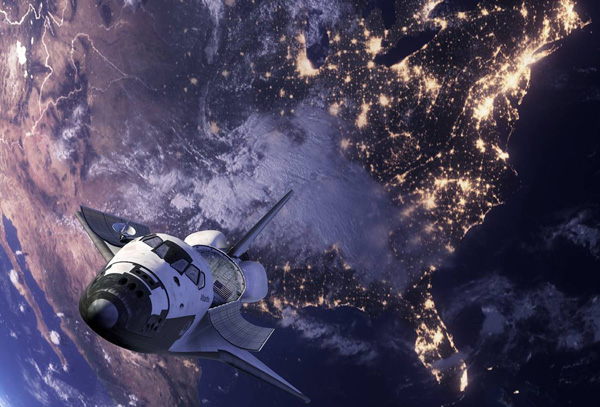
Eden FX created original digital sequences and animations for films displayed at the new Space Shuttle Atlantis attraction at Kennedy Space Centre.
Reach for the Stars |
|
Eden FX created original digital sequences and animations for films on display at the new Space Shuttle Atlantis attraction at Kennedy Space Centre Visitor Complex in Cape Canaveral. Florida. Eden started working on the project in December 2012 with Mousetrappe studio, where a team had begun production of a three-act presentation for visitors to the exhibit, set to open on 29 June 2013. Eden’s digital work includes the Space Shuttle Atlantis itself, an ‘Extra Vehicular Activity’ EVA Suit, the International Space Station, the Hubble Space Telescope, an Earth model, Hubble footage and other space-themed images. Astronaut’s InsightsWhen Mousetrappe first approached Eden FX, their creative team had a clear vision of what they needed and could provide a storyboard, a rough cut for timing and colour designs. Having worked with Mousetrappe on previous projects, Eden FX were already familiar with their style and art direction. They worked on this project over a total production time of five months with a fairly small team of just four core artists, four supplemental artists and creative direction from John Gross. |
 |
|
Colonel Searfoss’ descriptions of how it feels to be strapped into a pressure chair, listening to the final countdown on head phones and entering zero-gravity, gave the artists insights that directly influenced, for example, their design of a shot of the flight deck, and the most captivating sights an astronaut sees from space. His comments also came into play when sketching out the orbital path for the LED backdrop screen, deciding on the timing for the launch sequence, and animating the weightless space walker hanging above Earth. After his visit, they saw each shot in a new way. Background ResearchMousetrappe also provided Eden FX with a substantial amount of detailed, specific research and reference material directly from NASA headquarters and staff. They tracked down a rare, vintage photograph of the warehouse interior, and had NASA flight coordinators double-check the configuration of their model of the International Space Station to ensure they depicted it at the correct build-out stage of Atlantis' docking missions. They even gained access to the original Faget model glider for the pre-show. In order to protect the priceless glider, all flying shots were created in CG. |
 |
|
Christian said, “The look of Earth from space is very well documented, in part because astronauts all go through photographic training and are provided with exposure charts and details on the best lenses to use to capture high-resolution images while out on their missions. We set our CG camera to follow these charts as exactly as possible, and kept a lot of reference photographs open on a second monitor to closely match. ”Early in the process we took a field trip to the Kennedy Space Centre for a close up tour of the Shuttle Endeavour in the Orbital Processing Facility, where it was being prepared for the trip to Los Angles. Although the Atlantis was wrapped in plastic very early during the construction of the museum and only unpacked soon before the exhibit opened, we had plenty of photographic reference of the Atlantis to cross-reference with the Endeavor, which is very similar.” Eden FX was able to carry out the on-set supervision for the warehouse sequence, which included the standard camera data collection, taking reference photos and panoramic HDR images for lighting reference, and advising on the shoot to support their VFX workflow. Preparing for ProjectionInterestingly, it was also essential for the team to inspect the panoramic theatre at the Kennedy Space Centre visitor centre in its final stage of construction in order to gain a sense of the space and see how visitors would be immersed in the animations. They captured stills and panoramas from the intended sweet spots of the projection as well as from the back and front. “This way, we could confirm that our rendering approach would work and make sure we were providing a plausible view in all directions,” Christian said. “It was mind-blowing to see how large this theatre is and how much projection surface it has. It's one thing to plan out the specifications based on a blueprint, but it's entirely different to actually stand there. During this visit it became apparent that we had to render our shots in 8K - any lower resolution would fall apart.” |
 |
|
An on-site survey at the Space Center was necessary for the opening shot. When visitors first walk into the panoramic theatre they are surrounded by a nature scene at pre-dawn, which turns into a sunrise helicopter flight across a lake towards launch pad 39A, and then finally connects to the original IMAX plate of the launch in the early morning light. Everything except the launch footage needed to be CG, of course, but it had to be absolutely authentic. “Since the visitor centre is located at the front gate a mile away from the actual launch pad, we are showing a location that is technically inaccessible to most of our audience, but shows the same vegetation and landscape as the immediate surrounding area. Therefore, this shot had to look photorealistic enough to draw the visitor in,” said Christian. Alligator Bridge“The creatives from Mousetrappe, the Centre’s media guides and our team scouted out the exact location for the POV of our CG shot. The location had to match the angle of the IMAX plate, on the opposite shore of the lake. Once we found that, we took lots of reference photos of the surrounding vegetation and local wildlife. Then we returned to this spot the next morning, one hour before sunrise and took time-lapse footage of the sunrise so we could match sun direction and colour shift, and shot 16k panoramas at key moments of this daylight transition. ”It was a bit risky to acquire these panoramas. The location is an alligator bridge between the lake and a swamp, and sunrise is the time these beasts come alive. Our media guides stood on the back of the pickup truck, panning flashlights over the surrounding bushes, ready to call us off the ground. But in the end, these panoramas were invaluable, serving as a template for all the CG vegetation and beautiful lighting reference. The pre-dawn panorama is still visible as a far backdrop in the final opening shot.” |
 |
|
 |
|
Cloud Shader “But that still wasn't enough. We have built several Earth models at Eden FX, and a nagging problem has always been the clouds. The traditional method is to use a transparency map on a cloud layer, but this generally appears flat. Clouds would not interact well with side lighting, and the closer you get to the horizon the more they flatten out until they practically become thin pixel lines. Since our shot was permanently looking at the horizon and would depict clouds under constantly changing lighting conditions, we needed a better solution. “So we constructed a shader that would approximate the volumetric thickness of the clouds by using multiple texture layers with varying degrees of texture erosion. The shader even factored in the effects of backlight scattering in the lower cloud layers when passing over city lights. Our Earth model included an automatic daytime/night lights transition based on the sun direction, an atmosphere with physically based spectral colour transmission, and the rare Earth Glow - a phenomenon that happens on the outer most atmospheric layers over the darkest night side. Overall, we're quite proud of our Earth model!” Sunrise to Sunrise Animation involved creating a seamless loop of a realistic orbit that lasts 15,200 frames. What the audience sees is an orbit with a 55° inclination, which is the highest orbit flown on any shuttle mission. They start with a sunrise over the Pacific, flying over Baja California and then across the US mainland in a North-East direction, then cross the Great Lakes, Canada and the Atlantic, entering Europe over the UK, similar to the path of transatlantic airliners. For dramatic purposes Europe is shown at night, resulting in a dense network of sparkling city lights. The orbit then continues in a southeasterly direction over the Mediterranean, the Sahara desert, and the Middle East, at which point they switch back to daylight to display the desert colours. It gets dark again toward the Antarctic Circle, flying through the shimmering green Aurora Australis, then passing over the tip of Australia, across the length of New Zealand and heading out into the Pacific where the loop starts over at the beginning. In real life, a shuttle orbit took 90 minutes, or 60 without the Pacific so the 11-minute animation shows the orbit at about 6 times the original speed. A Hubble footage sequence that Eden FX created was initially approached as a re-creation shot of a nebula using a volumetric rendering system, but matching the exact, recognisable look of a Hubble photograph turned out to be extremely difficult. Since its purpose was mainly to highlight the achievements of Atlantis, which included the repair mission of the Hubble telescope, this shot could not simply be an artistic interpretation. Re-creating Stars“Shifting to a different approach, NASA provided us with a high-resolution photograph of a mountain of dust in the Carina Nebula. We painted out all the stars and manually split the image into seven depth layers,” said Christian. “Individual clouds of gas and dust were isolated and the occluded parts were reconstructed. Each layer was then individually dimensionalised with 3D sculpting techniques, so a dust cloud would actually be in the volumetric shape of a fluffy cloud. We staggered all these layers in depth and then animated the camera flying into it. “We had to re-create the stars themselves. We learned that there are basically two depth clues in a Hubble image - apparent luminance, visible as the size of the lens flare, and red shift. The redder and dimmer a star, the further away it is. Both are fairly weak clues, because real star size and real star colour also play a role, but nevertheless we used both clues to re-create the star field as accurately as possible. We also made sure to match the exact look of the Hubble star flares, even though they are not physically present when actually flying into the nebula with a camera.” Space NutsEden FX has been working on space-related shows and CG space imagery for more than a decade, both on fictional projects such as ‘Star Trek: Voyage’, ‘Deep Space Nine’ and ‘Enterprise’, as well in popular science including documentaries for Discovery Channel. Furthermore, the artists on the team describe themselves as ‘space nuts’. Throughout their careers, they have absorbed news and images from NASA relating to how space ships are constructed, how to make solar panels sparkle, where the atmospheric re-entry leaves scorch marks, how the Earth's bounce light affects low-orbit lighting and how the Earth's atmosphere looks from above. What made this project different and more exciting was receiving notes directly from the specialists at NASA. Christian remarked, “This was our chance to get it all right - to create the most mesmerizing Earth, to build the most detailed ISS, to have all the little things in place that make it make it photo-real and go beyond what is necessary for a purely fictional space tale. There is no better seal of approval for an orbit shot than having an eye witness, an actual astronaut, have a look at it and respond with a smile.” Dome CameraRendering the sequences for the dome projection became a particular challenge. The custom-built theatre has a flat screen in the front, but also contains four huge arches on both sides that stretch right across the ceiling. For a true, immersive experience, they could not use a standard CG camera, instead crafting a special dome camera type that was directly derived from the theatre geometry. They defined a sweet spot directly in the centre under the third arch. They would then shoot ray-tracing rays in the direction of all the walls and gather the resulting image pixels in a UV map for projection. “Looking at the CG scene literally reveals a wireframe model of the theatre floating through space, because this is what our custom CG camera looks like. So, we were really serious about our claims of taking the visitors into space!” Christian said. The team’s modelling, texturing and animation software pipeline consisted of modo and 3dsMAX for modelling, and for rendering and animation, they used LightWave 3D with the infiniMap texturing plug-in. “This plugin made it possible to stream gigabytes of textures directly from disk, in an on-demand-style similar to Google Earth,” Christian explained. “We have a variety of in-house plugins as well that take care of layer breakout, render passes and QuickTime generation for approval and delivery. Compositing was done in Digital Fusion, which also gave us the opportunity to simulate the dome theatre projection. This was a crucial step to make sure that our shots worked as intended and give us no unwelcome surprises when the shots were shown to visitors. “Initially our custom dome camera had the disadvantage of rendering only single-threaded. Even after stocking up our render farm until the power lines of our building were overstressed, render times were threatening our deadline. Thankfully, the entire LightWave team from NewTek was able to spend an extra night in the office to compile a special build of LightWave for us, which finally fixed this problem. Suddenly all our shots rendered about four times faster and we could wire all the final frames to Florida just in time for the grand opening.” www.edenfx.com CREDITS |


















